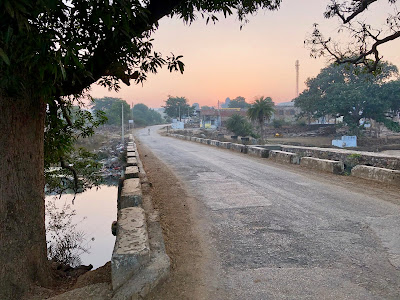12. Agra - Taj Mahal
Taj Mahal
Meaning "Crown of Palaces" it lies on the bank of the Yamuna river and was commissioned by Shah Jahan in 1632 to house the tomb of his wife, Mumtaz Mahal, who died in childbirth bearing their 14th child. Essentially completed in 1643 and entirely by 1653 costing in todays terms over £750 million and employed 20,000 artisans. It attracts up to 10 million visitors a year.
Like everyone, I have seen so many pictures of the Taj itself but I had no idea of what would surround it. When you approach the entrance to the Taj, this is all that you see, just the dome peeping out over the top of the wall!

As you approach you could see nothing and then it suddenly appeared but really looked like a backdrop for a film set!


The most spectacular feature is the main dome, over 100 ft high and close in measurement to the length of its base. Because of its shape it is often called an onion dome. Its shape is also emphasised by four smaller domed "chatters" placed at its corners, their bases open through the roof allowing light to the interior. The main finial, originally made of gold but a gilded bronze copy was made in the early 19th century, provides a clear example of an integration between Persian and Hindu tradition. It is tipped by a moon, a typical Islamic motif, whose horns point heavenward.
The minarets, each more than 130 ft tall complete the symmetry and were designed as working minarets to call the islamic faithful to prayer. Atop each tower is a chatter that mirrors the design of those on the tomb, topped by a golden finial. The minarets were designed to lean a fraction to the outside so in the event of any collapse they would fall outwards away from the tomb.
Between the tomb and the gateway is a raised water tank with a reflecting pool positioned on a north-south axis to to reflect the image of the mausoleum. The tank is called "al Had al-Kawthar" in reference to the "Tank of Abundance" promised to Muhammad.
Early accounts of the garden describe its profusion of vegetation, including abundant roses, daffodils and fruit trees. As the Mughal Empire declined so did the Taj Mahal and its gardens. By the end of the 19th century the British Empire controlled more than three-fifths of India and assumed management of the Taj, changing the landscape to one more closely resembling the formal lawn of London.
Between the tomb and the gateway is a raised water tank with a reflecting pool positioned on a north-south axis to to reflect the image of the mausoleum. The tank is called "al Had al-Kawthar" in reference to the "Tank of Abundance" promised to Muhammad.
Early accounts of the garden describe its profusion of vegetation, including abundant roses, daffodils and fruit trees. As the Mughal Empire declined so did the Taj Mahal and its gardens. By the end of the 19th century the British Empire controlled more than three-fifths of India and assumed management of the Taj, changing the landscape to one more closely resembling the formal lawn of London.

The Gang


The exterior decorations are among the finest in Mughal architecture. As the surface area changes the decorations are refined proportionately. The decorations were created by applying paint, stucco, stone inlays and carvings and follow the Islamic prohibition against the use of anthropomorphic forms and throughout the complex are quotations from the Qur'an. Higher panels are written in slightly larger script to reduce the skewing effect when seen from below. Mortared areas of the marble building have been stained or painted in a contrasting colour which creates a complex array of geometric patterns. On the lower walls of the tomb the marble has been polished and the inlaid stones of yellow marble, jasper and jade have been polished and levelled to the surface of the walls.
The interior goes a step further using a lapidary of precious and semiprecious gemstones. The inner chamber is an octagon with 82 feet high walls, topped by a false interior dome decorated with a sun motif. Light enters through marble balcony screens and through the roof openings created by the chattris in the corners. The octagonal marble screen or jali is made from eight marble panels carved through with intricate pierce work.
The tomb is the central focus of the entire complex of the Taj Mahal, and like most Mughal tombs its basic elements are Persian in origin. Mumtaz Mahal's tomb is at the very centre, her husband's on the western side is the only visible asymmetric element of the entire context would suggest that Shah Jahan's inclusion was a later decision. These sarcophagi housed in this main chamber are in fact false, the actual graves are at a lower level, simply decorated in muslim tradition, and their occupants have their faces turned to the right towards Mecca.

The Taj complex is bordered on three sides by crenellated red sandstone walls but the side facing the Yamuna river is open and some historians argue that the river was intended to be part of the garden design and meant to be seen as one of the rivers of paradise.


Two grand red sandstone buildings mirror each other, facing the sides of the tomb. The western building is a mosque and the other is the "jawab" (answer), probably used as a guesthouse and constructed for architectural balance. The jawab lacks a mihrab (a niche in the mosque wall facing Mecca)and the outlines of 569 prayer mats in black marble.

The mosque.
The area on which the Taj was built was raised and levelled and then rather than using lashed bamboo for scaffolding workmen constructed a huge brick scaffold that mirrored the Taj, it was so enormous that the site foreman estimated that it would take years to dismantle. However, according to legend, once the construction Shah Jahan decreed that anyone could keep the bricks they took down and it was taken down by peasants overnight!
It was constructed using materials from all over India and Asia and it is believed that over 1000 elephants were used to transport materials. The translucent white marble came from Rajasthan, jasper from the Punjab, jade and crystal from China, turquoise from Tibet, lapis lazuli from Afghanistan, sapphire from Sri Lanka and carnelian from Arabia.
A 15 km tampered earth ramp was built to transport marble and materials up to the construction site and teams of 20 or 30 oxen pulled the blocks on specially constructed wagons. An elaborate pulley system was then used to raise the blocks into the desired position. Water was drawn up from the river by a series of "purs" an animal-powered rope and bucket mechanism.


This lantern hangs in the gateway a you leave and casts shadows on the wall - how many other people have gazed at this at they have left? I felt drunk with all the wonderful things that I had seen that day.












Comments
Post a Comment